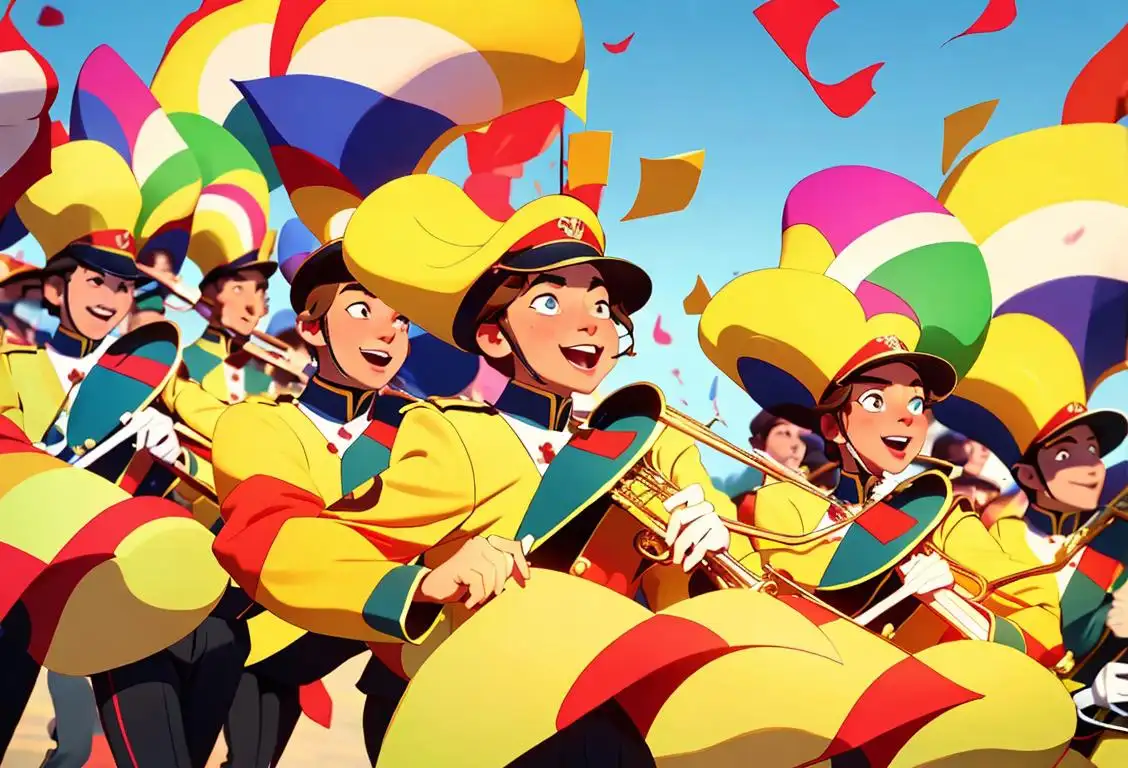National Ukulele Day

Ah, the ukulele! That tiny instrument that brings so much joy and tropical vibes wherever it goes. It's time to celebrate National Ukulele Day, the day dedicated to all things uke! So grab your ukulele, strum a few chords, and let's dive into the fascinating history of this delightful instrument.
When is Ukulele Day?
It's national ukulele day on the 2nd February.
A Brief History of the Ukulele
The ukulele, with its four strings and endearing sound, originated in the 19th century in Hawaii. It's believed to have been inspired by the Portuguese braguinha or rajão, which were brought to the islands by Portuguese immigrants. The Hawaiians quickly fell in love with this unique instrument, making it an integral part of their musical culture.
In the early 20th century, the ukulele gained popularity worldwide, thanks to its appearance in vaudeville shows and Hollywood movies. Its cheerful sound and compact size made it a hit among performers and music enthusiasts alike.
Online Ukulele Community
In the age of the internet, the ukulele has found a new home online. Websites, forums, and social media platforms dedicated to the ukulele have blossomed, bringing together players from all around the world. These virtual communities provide a space for beginners to learn, share tips and tricks, and connect with fellow ukulele enthusiasts.
Many popular musicians have also embraced the ukulele, adding its charming sound to their songs. We've seen the likes of Eddie Vedder from Pearl Jam and Jason Mraz strumming away on their ukes. It just goes to show that the humble ukulele can hold its own in any genre of music.
Celebrating National Ukulele Day
On National Ukulele Day, people of all skill levels come together to celebrate the ukulele. Whether you're a seasoned player or just starting out, this is the perfect time to showcase your ukulele skills and share your love for this instrument.
Host a ukulele jam session with your friends, start a ukulele club in your community, or simply spend the day strumming your favorite tunes on your porch. Get creative and spread the joy of the ukulele to everyone around you. After all, the ukulele is all about having fun and bringing people together.
History behind the term 'Ukulele'
1879
The Arrival of the Braguinha
In 1879, Portuguese immigrants in Hawaii brought a small four-stringed instrument called the braguinha, which became the precursor to the ukulele. The braguinha, also known as the machete or cavaquinho in Portugal, was a popular instrument in Madeira and the Azores. Its introduction to Hawaii marked the beginning of the ukulele's journey.
1879
The Arrival of the Rajão
In 1879, the Portuguese immigrants brought a small four-stringed instrument called the Rajão to Hawaii. It was similar in size to a guitar and had a distinct sound. The Rajão became quite popular among the people of Hawaii, including the locals and immigrants alike.
1879
Introduction of the machete
In 1879, Portuguese immigrants brought a small guitar-like instrument called the machete to the island of Madeira. The machete had four strings and was played with the fingers or a pick. This instrument would later evolve into the ukulele.
1879
Introduction of the ukulele
In 1879, Portuguese immigrants arrived in Hawaii with a small four-stringed instrument called the machete, which is a predecessor of the ukulele. The Hawaiians were enthralled by its sound and started adopting and modifying it to create their own unique instrument.
1879
The Arrival of the Braguinha
In 1879, a Portuguese immigrant named João Fernandes arrived in Hawaii carrying a small guitar-like instrument called the braguinha. This instrument, which was a precursor to the ukulele, had four strings and a distinctive sound. Fernandes started performing with the braguinha, captivating the locals with its unique tone.
1886
Aloha to the Machete
Five years later, a Portuguese immigrant named Manuel Nunes arrived in Hawaii with a similar instrument known as the machete. Nunes, along with his fellow Portuguese craftsmen Augusto Dias and Jose do Espirito Santo, began producing and selling machetes to the Hawaiian locals. These instruments quickly gained popularity, becoming a staple in Hawaiian music.
1886
Famous concert leads to ukulele popularity
In 1886, three Portuguese immigrants performed at a royal concert in Hawaii. They played the machete, captivating the audience with their lively and catchy tunes. This performance rapidly spread the popularity of the machete, and it became an integral part of Hawaiian music culture.
1880s
The Birth of the Ukulele
In the 1880s, indigenous craftsmen in Hawaii began adapting and modifying the Rajão, creating a new instrument that would eventually become known as the ukulele. These craftsmen reduced the number of strings from four to just four, using gut strings or later steel strings, and modified the size and shape of the body, resulting in a smaller, more resonant instrument with a unique sound.
1880s
Adapting the Braguinha
As the braguinha gained popularity in Hawaii, Portuguese luthiers and musicians began adapting the instrument to suit the local taste. The braguinha's body was made slightly larger, the strings were changed, and it was given a Hawaiian name, ukulele, which means 'jumping flea'. This name perfectly captured the nimble finger movements needed to play it.
1886
Performance at a royal celebration
In 1886, Portuguese cabinet maker Manuel Nunes, along with his friends Augusto Dias and João Fernandes, introduced the machete to Hawaii. They performed with the instrument at a royal celebration, captivating the audience with its unique sound.
1889
The Name 'Ukulele' is Born
The word 'ukulele' itself has an interesting origin. It was derived from the Hawaiian words 'uku,' meaning 'flea,' and 'lele,' meaning 'jump.' The small size and fast finger movements required to play the instrument led Hawaiians to compare it to the agile movements of fleas. Thus, the term 'ukulele' was coined to describe this unique instrument.
1888
The name 'ukulele' is coined
The term 'ukulele' was officially coined in 1888. It is believed to mean 'jumping flea' in Hawaiian, possibly due to the fast finger movements of the players resembling the movement of fleas. The name quickly gained popularity and became associated with the instrument.
1915
The Panama-Pacific International Exposition
The ukulele gained significant popularity in 1915 when the Panama-Pacific International Exposition was held in San Francisco. The Hawaiian Pavilion at the exposition showcased ukulele performances, captivating the audience and introducing the instrument to a wider audience. This event marked a turning point in the ukulele's journey from a local Hawaiian instrument to a global phenomenon.
1915
Panic at the Panama-Pacific International Exposition
In 1915, the Panama-Pacific International Exposition, a world's fair held in San Francisco, introduced the ukulele to a wider American audience. The Hawaiian Pavilion showcased musicians playing the ukulele, sparking a major craze across the country. Sales skyrocketed, and the ukulele became a symbol of the carefree and exotic Hawaiian lifestyle.
1893
Name change to ukulele
In 1893, the name of the instrument was officially changed from machete to ukulele. The word 'ukulele' translates to 'jumping flea' in Hawaiian, possibly referring to the performers' nimble fingers as they played the instrument. The name perfectly captured the lively and joyful nature of the ukulele's sound.
1915
Ukulele gains popularity worldwide
The Panama-Pacific International Exposition held in San Francisco in 1915 played a significant role in popularizing the ukulele worldwide. The exposition showcased the cultures and traditions of various countries, introducing the ukulele to a vast international audience. Its unique sound and portability made it a hit among musicians and enthusiasts around the globe.
1893
Ukulele in the Panama-Pacific Exposition
The ukulele gained international recognition in 1893 when it was featured at the Panama-Pacific Exposition in San Francisco. The exposition showcased various cultures and their musical traditions, and the ukulele gained attention for its charming and distinctive sound.
1920s
The Jazz Age and Ukulele's Rise to Popularity
During the 1920s, the Jazz Age, the ukulele soared to new heights of popularity. Its small size, affordability, and easy learning curve made it accessible to a wide range of people. In addition to traditional Hawaiian music, the ukulele became a staple of jazz and popular music, with famous musicians like Cliff Edwards (also known as Ukulele Ike) showcasing its versatility.
1920s
Ukulele's Rise to Popularity
During the 1920s, the ukulele experienced a surge in popularity around the world, particularly in the United States. Its joyful sound and compact size epitomized the carefree spirit of the Roaring Twenties. The ukulele became a staple of vaudeville acts and musical performances, igniting a craze that led to millions of ukuleles being sold across the country.
1915
Ukulele Conquers the Mainland
During the Panama-Pacific International Exposition held in San Francisco in 1915, ukulele groups from Hawaii performed, captivating the audience and introducing the instrument to a wider audience. The ukulele's sweet and cheerful sound resonated with people, leading to a surge in popularity and the instrument's spread across the United States.
20th Century to Present
Ukulele's Cultural Impact
The ukulele has continued to captivate musicians and enthusiasts throughout the 20th century and into the present day. Its distinctive sound can be found in various genres of music, from traditional Hawaiian music to pop, rock, and even jazz. The instrument has played a significant role in shaping the sound and culture of Hawaii, and its versatility and accessibility have made it a beloved instrument worldwide.
20th century
Ukulele becomes a symbol of Hawaiian music
Throughout the 20th century, the ukulele continued to thrive in Hawaiian music culture. It became synonymous with laid-back island vibes and was often associated with Hawaiian hula dancers. The instrument's popularity surged with the release of iconic Hawaiian songs, like 'Sweet Leilani' and 'Aloha 'Oe,' featuring ukulele melodies.
1950s
Ukulele Dips in Popularity
As the 1950s arrived, the ukulele experienced a decline in popularity. The rise of rock 'n' roll and electric guitars overshadowed the quaint charm of the ukulele. However, it continued to have a dedicated following in Hawaii, where it remained an integral part of the local musical culture.
1915
Ukulele craze in the United States
In 1915, the Panama-Pacific Exposition helped spark a ukulele craze in the United States. American audiences were enchanted by the sound and portable size of the instrument. It became a popular choice for amateur musicians and gained a prominent place in popular music during the Roaring Twenties.
1920s
Ukulele Mania Sweeps the Nation
The 1920s marked the peak of ukulele popularity in the United States. Famous musicians like Cliff Edwards, known as 'Ukulele Ike,' popularized the instrument through recordings and performances, making it a symbol of fun and joy in the roaring twenties. The ukulele's compact size and affordability made it accessible to people from all walks of life, leading to a widespread ukulele craze.
1940s
Ukulele in the War
During World War II, the ukulele played a significant role in boosting morale among the troops. Soldiers would bring their ukuleles to the front lines, using music as a way to cope with the challenges of war. The instrument became a symbol of hope and resilience during this tumultuous time.
1940s
Revival in Hawaii
During the 1940s, the ukulele experienced a revival in Hawaii. The instrument became a symbol of Hawaiian culture and was featured in traditional music, hula performances, and even Hollywood films set in Hawaii. This period solidified the ukulele's status as an icon of Hawaiian music.
1990s
The Ukulele's Comeback
In the 1990s, the ukulele experienced a resurgence in popularity thanks to musicians like Israel Kamakawiwo'ole and Jake Shimabukuro. Their viral performances, such as Kamakawiwo'ole's rendition of 'Over the Rainbow/What a Wonderful World' and Shimabukuro's stunning ukulele covers, brought the instrument back into the global spotlight. Today, the ukulele's popularity continues to grow, with enthusiasts worldwide embracing its joyful sound.
2000s
Modern Ukulele Renaissance
In recent years, the ukulele has experienced a resurgence in popularity. Musicians like Jake Shimabukuro and Israel Kamakawiwoʻole have gained international acclaim for their ukulele performances, introducing the instrument to a whole new generation. The ukulele's versatility and its ability to evoke feelings of happiness and nostalgia have made it a beloved instrument worldwide.
21st century
Global popularity
In the 21st century, the ukulele has experienced a resurgence in popularity worldwide. Its compact size, accessibility, and cheerful sound have made it a favorite instrument for people of all ages and musical backgrounds. The ukulele can now be found in various genres of music and has even inspired dedicated ukulele festivals and communities.
Did you know?
Did you know that the world's largest ukulele ensemble was formed in Yokohama, Japan? In 2012, a staggering 6,818 ukulele players gathered to strum and pluck their way into the Guinness World Records!Tagged
fun community musicFirst identified
29th January 2016Most mentioned on
2nd February 2021Total mentions
182Other days
Go Caroling Day
Ukulele Day
Katycat Serve Day
Marching Arts Day
Riky Rick Day
Juggalo Day
Thug Day
Cheese Pizza Day
Pabebewave Day
Law Day







